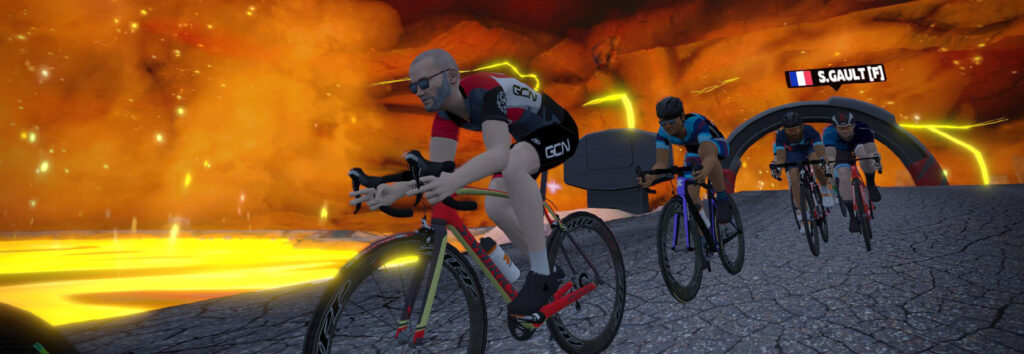Indoor cycling is hot and sweaty, there’s no doubt about that. Even if you bring your setup into a cold winter garage, you could be dripping sweat in just 15 minutes.
The heat and humidity are only part of the challenge of riding indoors on Zwift. Many cyclists enjoy high-intensity interval training (HIIT) or racing indoors. One of the biggest reasons cyclists ride the indoor trainer is the ability to complete structured workouts uninterrupted.
But fueling for a 45-minute HIIT session is much different from fueling for a 3-hour endurance ride. Add the heat and humidity of riding indoors, and your workout nutrition should look completely different.
Here’s how to adjust your workout nutrition for riding indoors on Zwift.
Tip #1: Fuel your high-intensity workouts with carbohydrates
More often than not, we ride at high intensities on the indoor trainer. If you’re sticking to Zones 1 and 2, then fueling with fats and a moderate amount of carbs will get you through your workout. Try fueling with nuts, protein and low-carb bars, some real fruit, or sports nutrition (10-20 grams per hour) during low-intensity training rides.
Before a HIIT session or Zwift race, have a balanced meal 3-4 hours before your ride, then top it off with a small amount of carbohydrates 15-30 minutes before the session. This pre-ride snack can be a banana, energy gel, sports drink, or electrolyte drink (more on electrolytes below).
For those who ride early in the morning before breakfast, have a carbohydrate-filled snack before your ride, such as toast with honey, granola clusters, or an energy gel.
Tip #2: Drink more
When riding the indoor trainer, you are surrounded by air that sits. Instead of blowing across your face like a refreshing breeze, the air around you is basically motionless. This leads to more heat and humidity, a higher sweat rate, and a higher core temperature.
One study found that adding a fan to your indoor cycling setup can increase cycling endurance by 109%. Just by adding airflow, the study participants were able to last more than twice as long during an indoor cycling ramp test!
With less airflow, your core temperature increases while your performance plummets. This is why fans are the #1 cooling device for indoor cyclists. Fans keep the air around us moving, allowing sweat to evaporate from our bodies rather than collecting on our skin like we’re in a sauna.
You can also combat these effects by drinking more and drinking cool liquids. Aim to drink at least 18-26 oz of fluid every hour. A standard cycling water bottle is 20 oz, so aim to drink at least one bottle per hour and 1-1.3 bottles per hour if you are riding at high intensities.

Tip #3: More heat = more carbohydrates
In high heat conditions, our bodies burn more carbohydrates relative to ambient conditions. One study showed that cyclists burned significantly more carbs than fat in hot, dry conditions (36° C; 25% relative humidity).
This emphasizes the importance of carbohydrate intake when riding indoors on Zwift. Your body’s carbohydrate needs may be higher than you think!
Most cyclists should consume 30-60 grams of carbohydrates per hour during a hard workout or race, but this number can vary. You have to train your gut to process >30 grams of carbohydrates per hour, so don’t jump into the deep end right away. Professional cyclists can process over 100g/hr, but that takes years of gut training.
On the indoor trainer, aim to consume at least 30g/hr of carbohydrates during rides longer than an hour. As you feel confident that you can stomach 30g of carbs per hour without stomach discomfort, increase your carb intake week by week until you reach as much as 50-100g of carbs per hour.
Just like training your legs and lungs, you need to train your gut in an organized and progressive manner. The best way to train efficiently and effectively is to use a structured training plan, both for your gut and for your cardiovascular fitness.
Carbohydrate consumption is most important for rides or workouts longer than an hour. Inside of 60 minutes, your body will have plenty of carbohydrates on board from the meal 3-4 hours before your ride. But if you’re riding before breakfast, make sure to fuel with carbohydrates every 30 minutes since your glycogen stores are not topped off.
Tip #4: Take in electrolytes before your ride, if possible
Sweat contains a certain amount of sodium and salt that often crusts our cycling kit with starchy white streaks. Some of us have very high concentrations of sodium in our sweat, while others have very little. While sweat composition varies significantly from person to person, it is generally consistent across workouts for each individual. In other words, your unique sweat rate and composition should remain consistent across workouts.
Regardless of your individual sweat composition, you should be taking in electrolytes before and during your workouts, if possible. Electrolytes are even more important on the indoor trainer when your sweat rate is at its maximum.
Start with consuming one small serving of sports drink electrolyte mix or tablets before an indoor trainer workout on Zwift. See how your stomach reacts and how you feel during your workout.
If you are a heavy sweater or have a high amount of salt in your sweat, try moderately increasing your pre-Zwift electrolyte intake over time. Heavy sweaters may have one serving of electrolytes before their ride and two servings during their workout. Remember that sweat rates and concentration are highly individual, so take time to experiment with different amounts of carbohydrates and electrolytes to see what works best for you.
Takeaways for Indoor Zwift Workouts vs. Outdoor Workouts
- Hydrate more, targeting 1-1.3 bottles per hour
- Consume more carbohydrates, trying to achieve 50-100g of carbs per hour
- Take some pre-workout electrolytes to top up before the ride
- Always consume carbohydrates prior to intense Zwift workouts and races
Questions or Comments?
Post below!

